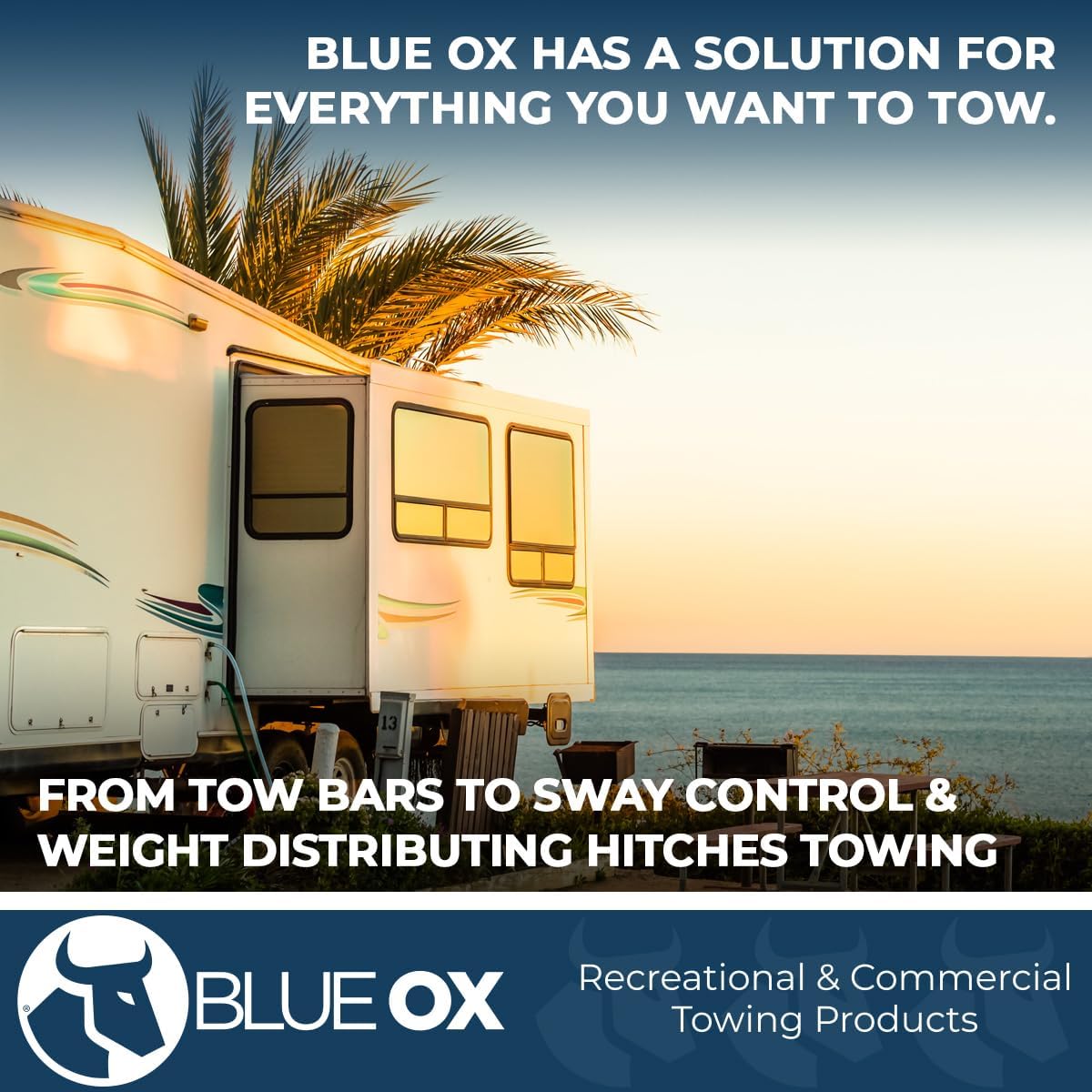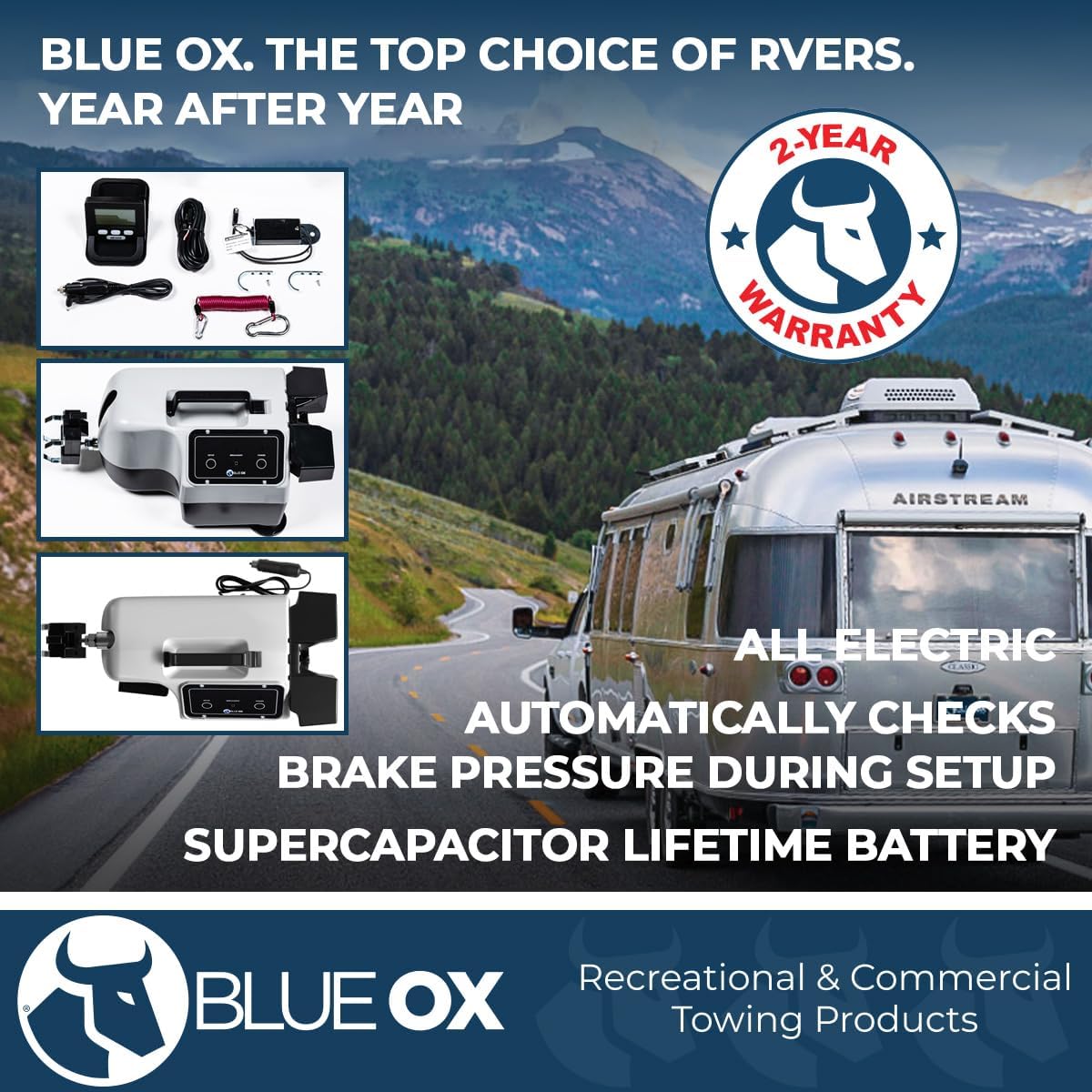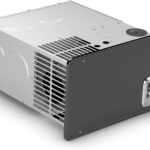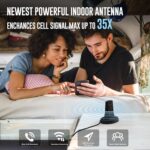Looking for a reliable flat tow brake that gives you confidence on long trips with your RV?
Blue Ox BRK2022 Patriot Flat Tow Brake — Quick Overview
You want a flat tow brake that feels modern, reliable, and easy to use, and the Blue Ox BRK2022 Patriot Flat Tow Brake positions itself that way. This model is an all-electric supplemental braking system that continuously monitors brake pressure while you’re towing, includes an in-coach controller with an extended RF range, is compatible with most vehicles (including hybrids, except the Fiat 500), and comes with a two-year warranty.
Key Features
You’ll appreciate a clear list of what the Patriot brings to the road. The following features define how it works and what it can do for your towing setup.
| Feature | What it is | Why it matters |
|---|---|---|
| All-electric design | Uses electric actuators rather than vacuum or air | Cleaner integration with modern vehicles and hybrid/electric drivetrains |
| Continuous brake pressure monitoring | Tracks how much force is being applied during towing | Helps ensure braking matches coach input consistently and safely |
| In-coach controller with extended RF range | Controller sits inside your RV and communicates wirelessly with the brake unit | Lets you adjust settings from the driver’s seat and maintain signal even with large motorhomes |
| Broad vehicle compatibility | Works on most cars, SUVs, and hybrids (excludes Fiat 500) | Reduces compatibility worries and simplifies product choice |
| Two-year warranty | Manufacturer-backed warranty for parts and workmanship | Gives you peace of mind for the first couple of years of ownership |
All-electric design
You’ll notice the design avoids vacuum or air-based actuators, relying instead on electric components to operate the towed vehicle’s brakes. That means you rarely have to worry about vacuum line compatibility, and it’s a more modern fit for hybrids and electric vehicles.
Continuous brake pressure monitoring
You get real-time monitoring of brake pressure while towing, which helps maintain consistent braking feel and safety. Continuous monitoring also allows the system to respond quickly to changes in coach braking intensity, giving you smoother stops.
In-coach controller and extended RF range
The included in-coach controller lets you make on-the-fly adjustments without leaving the driver’s seat, and the extended RF range is designed to work well with large motorhomes and potential signal obstructions. You’re less likely to lose connection, which is vital for safe and reliable braking control.
Compatibility with vehicles and hybrids (except Fiat 500)
This system supports a wide range of vehicles, including many hybrids and modern drivetrains, which is important if you drive a non-traditional powertrain. Note that the Fiat 500 is an exception; always check vehicle-specific compatibility before you buy.
Two-year warranty
A two-year warranty covers defects and many common early life issues, giving you a safety net after purchase. Warranty terms vary, so you should read the fine print for coverage details and what actions might void the warranty.
Installation and Setup
You want installation that’s straightforward but secure, and the Patriot is designed for RV owners who prefer a professional install or a confident DIY approach. Below is a practical look at what to expect when fitting this unit.
What you’ll need before starting
You’ll need basic hand tools, a wiring kit (typically included or sold with the kit), mounting hardware, and a clean, level surface to work on. If you’re unfamiliar with vehicle electrical systems or brake components, plan for a professional installation to ensure safety and proper operation.
Step-by-step installation overview
First mount the electric actuator assembly on the towed vehicle as per Blue Ox guidelines, then set up the in-coach controller inside your RV. After physical installation, perform the calibration steps to match brake pressure levels to your coach. Each step should be followed methodically — improper installation or calibration can reduce braking performance or risk damage to either vehicle.
Time and difficulty expectations
If you’re experienced with trailer and RV equipment, you might finish in a few hours; if not, expect a half- to full-day job for a professional-quality install. Some users prefer having an experienced shop handle it the first time to avoid troubleshooting under stress.
Safety checks after installation
After installation, perform multiple test stops at low speed in a safe area to confirm operation. Check for loose wiring, proper actuator movement, and that the in-coach controller responds consistently before hitting the highway.
Performance on the Road
You want braking that’s consistent, predictable, and easy to tune for different conditions. This model tends to provide a smooth, incremental braking response that you can adjust from the RV.
Braking feel and responsiveness
The Patriot delivers an electrically controlled braking feel that you can fine-tune from the in-coach controller, helping you maintain consistent stopping distance and a comfortable ride for occupants. The continuous monitoring feature helps the system mirror the braking intensity coming from the coach, reducing abrupt or laggy stops.
Tuning and adjustability
You can change gain and sensitivity settings to match your towing style, road conditions, and towed vehicle weight. Whether you prefer a softer touch in city driving or firmer engagement on steep declines, you can adapt settings without needing to stop and get out of the coach.
Behavior at low speeds and during parking
At very low speeds or when maneuvering in tight spaces, you’ll want to keep the controller’s sensitivity lower to avoid unintentional engagement. The Patriot’s adjustable controls allow you to set a threshold where the towed brakes remain passive during parking or slow-speed maneuvers, preventing unnecessary resistance.
Safety and Reliability
You want a product that prioritizes safety and gives you consistent performance over many miles. The Patriot’s monitoring capabilities and electric design aim to deliver that peace of mind.
Monitoring and fail-safes
Continuous brake pressure monitoring helps the system detect anomalies and maintain consistent braking output. If you ever notice odd behavior, the controller’s diagnostics can help identify signal or pressure issues early.
Power and electrical reliability
Because the system is all-electric, you don’t have to worry about vacuum leaks or air pressure loss; however, you must monitor the electrical connections and fuses. A secure connection and good battery voltage will keep the unit performing reliably.
Regular inspection points
You should include the Patriot in your pre-trip inspections, checking actuator mounts, electrical harnesses, and controller connectors for wear or looseness. Early detection of problems prevents unsafe conditions on the road.
Compatibility and Vehicle-Specific Notes
You’ll need to confirm that your vehicle is on the compatibility list before buying. While the Patriot supports many makes and models, the Fiat 500 is explicitly excluded.
Hybrids and electrified vehicles
Because of the all-electric approach, the Patriot is a good match for hybrid vehicles that don’t have traditional vacuum systems. It avoids some of the pitfalls older braking systems face with modern hybrids and electrics.
Manual vs. automatic transmissions
The Patriot works with most manual and automatic transmissions when the towed vehicle is set up correctly for flat towing. If your vehicle requires gear-specific procedures (neutral, park, etc.), follow manufacturer flat towing recommendations in addition to the braking system instructions.
What about larger trucks and SUVs?
The system is primarily designed for passenger vehicles and light SUVs that are flat-towable. For heavier towed loads, verify the Patriot’s range and braking capacity with Blue Ox or your installer to ensure it’s a proper match.
Pros and Cons
You want a balanced view before committing. Here’s a straightforward list that helps you weigh the Patriot’s strengths and limitations.
Pros
- All-electric design compatible with hybrids and modern vehicles.
- Continuous brake pressure monitoring for consistent braking behavior.
- In-coach controller with extended RF range makes adjustments easy and safe.
- Broad compatibility across makes and models (except Fiat 500).
- Two-year warranty provides initial peace of mind.
Cons
- The Fiat 500 is not supported, so that specific model is excluded.
- Professional installation is recommended for many users, which adds cost.
- Like any electrical device, it requires periodic checks of wiring and connections.
- If your towed vehicle has unique brake or electrical setups, you may need special adapters or custom installation.
How it Compares to Other Options
You want to understand how the Patriot stacks up against other solutions on the market. The Patriot emphasizes electric actuation and in-coach control, which positions it differently than portable or vacuum-based systems.
In-coach vs portable brakes
Compared to portable supplemental braking units that attach to the brake pedal or vacuum-based systems, the in-coach Patriot offers cleaner integration and more precise control. Portable units can be convenient for short-term needs, but they may not match the Patriot’s consistency and neatness of installation.
Electric actuation vs vacuum/air systems
Electric actuation is typically more compatible with modern powertrains, especially hybrids and electric vehicles, where vacuum sources may be absent or unreliable. Vacuum and air systems can work well but sometimes require modifications or are less suitable for hybrids.
Value for frequent towers
If you tow regularly, the Patriot’s professional installation and robust feature set tend to pay off in usability and reliability. For occasional tuggers, the upfront cost and installation might feel heavy compared to portable alternatives, but the on-road performance can be superior.
Troubleshooting Common Issues
You want to know how to handle problems if they appear on the road. The following troubleshooting steps address the most common scenarios.
No power to in-coach controller
First check fuses and battery connections in the coach, then ensure the controller’s power switch is on. If power is present but the controller is unresponsive, inspect wiring harness plugs and for water intrusion or damaged pins.
Weak or inconsistent braking
Check actuator mounting bolts and ensure the actuator stroke isn’t obstructed. Inspect the controller settings — sensitivity or gain may be set too low — and verify that the system is calibrated to your towed vehicle’s brake geometry.
RF signal loss or interference
Make sure there are no large metal obstructions between the coach controller and the towed vehicle; repositioning the controller slightly or changing its orientation can help. If you suspect interference, switch to a different channel if the controller supports it and verify that other devices in the coach aren’t causing signal noise.
Audible or mechanical noises during operation
Unusual noises often indicate loose hardware or misalignment. Stop promptly and check actuator mounts, linkages, and connectors for tightness and abrasion. Replace any frayed wiring or worn brackets before continuing.
Maintenance Tips
You want the Patriot to last and perform without surprises. Regular care and a few simple habits keep things in top condition.
Routine inspection schedule
Inspect mounts, harnesses, and the actuator every 3,000–5,000 miles or before long trips. Look for loose bolts, cracked connectors, or any sign of wear and address them promptly.
Electrical system care
Keep electrical connections clean and dry, and ensure the coach’s battery and charging system provide stable voltage to the controller. Corroded terminals and weak batteries are common sources of intermittent faults.
Storage and off-season care
If you store your towed vehicle or RV for long periods, disconnect or cover the actuator and controller to prevent dust and moisture ingress. Periodically power the controller to confirm it still boots up and maintains proper settings.
Who Should Buy It?
You want a clearer picture of whether the Patriot matches your towing needs. This unit suits drivers who tow frequently, value modern integration, and drive hybrids or electric vehicles.
Ideal buyers
- RV owners who tow a passenger car or light SUV regularly.
- Drivers of hybrid vehicles wanting an electric-based supplemental braking solution.
- Users who prefer in-coach control and easy adjustability while underway.
Who might look elsewhere
- Owners of non-flat-towable vehicles or vehicles not compatible with the Patriot.
- Occasional towers who prefer a portable, non-permanent solution for sporadic use.
- Owners of vehicles with unique braking systems that need custom engineering beyond standard kits.
Frequently Asked Questions (FAQ)
You probably have follow-up questions before deciding, and the answers below address common concerns.
How does an all-electric system differ in routine care?
An all-electric system removes vacuum and air concerns but brings electrical maintenance into focus, so you’ll be checking wiring, fuses, and connectors instead of hoses and reservoirs. Ensuring a steady 12V supply and clean contacts is the main routine task.
Will it damage my towed vehicle’s brake system?
When installed and calibrated correctly, the Patriot is designed to work without causing damage. Proper setup ensures the actuators apply force within safe limits. Incorrect installation or excessive settings, however, can increase wear, so calibration is important.
Can I install it myself?
If you’re experienced with vehicle wiring and accessory installation, you may handle it as a DIY project; otherwise, a professional installation is recommended. Professional installers will ensure correct mounting, safe wiring, and proper calibration.
What happens if the RF signal is lost while towing?
The system is designed to minimize risk if RF communication is interrupted; however, losing signal can affect braking responsiveness, so maintaining a reliable connection is important. RF loss troubleshooting typically involves checking antenna orientation, controller position, and potential sources of interference.
How often should I replace parts?
There’s no fixed lifespan for all components; inspect mechanical and electrical parts regularly and replace as soon as you see wear. Your two-year warranty covers many early faults, but long-term wear items should be serviced or replaced based on inspection findings.
Common Installation Questions You’ll Want Answered
You’ll have specific questions when installing or specifying the Patriot. These short answers focus on practical next steps.
Do you need a baseplate?
Yes, most flat-tow configurations require a baseplate that mounts to your towed vehicle’s frame and provides anchor points for towing hardware and the braking actuator. Ensure the baseplate you choose is vehicle-specific and compatible with the Patriot’s actuator mounting.
Is special wiring required for hybrids?
Often you’ll need to follow manufacturer instructions for placing the vehicle in the proper tow mode and verifying the neutral and brake systems. The Patriot’s electric actuation simplifies compatibility, but clear, vehicle-specific steps are required for many hybrids.
Are replacement parts easy to get?
Replacement parts and service are generally available through dealers and Blue Ox’s support network, but availability can depend on region and distributor stock. Keep your installation manual and part numbers handy for faster ordering.
Final Verdict
You want a concise recommendation after reviewing all aspects, and the Blue Ox BRK2022 Patriot Flat Tow Brake delivers a compelling mix of modern features, compatibility, and control for frequent towers. Its all-electric design and continuous pressure monitoring make it a strong choice for owners of hybrids and other modern vehicles, while the in-coach controller and extended RF range enhance usability for RV drivers.
If you tow regularly and want a robust, integrated solution rather than a temporary kit, the Patriot is worth serious consideration. Verify vehicle compatibility (note the Fiat 500 exclusion), budget for professional installation if needed, and commit to regular inspection for the safest and most reliable experience.
Additional Tips Before You Buy
You’ll make a better purchase with these practical steps:
- Confirm your vehicle is compatible with the Patriot before buying.
- Budget for professional installation if you’re not fully comfortable with wiring and brake systems.
- Keep the owner’s manual in the coach and perform brief pre-trip checks each outing.
- Register your product and understand warranty terms so you can act quickly if an issue appears.
If you want, I can help you check compatibility for a specific vehicle, outline a suggested pre-trip checklist for the Patriot, or draft a questions list to take to an installer. Which would you like to do next?
Disclosure: As an Amazon Associate, I earn from qualifying purchases.












